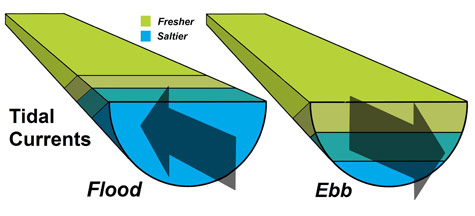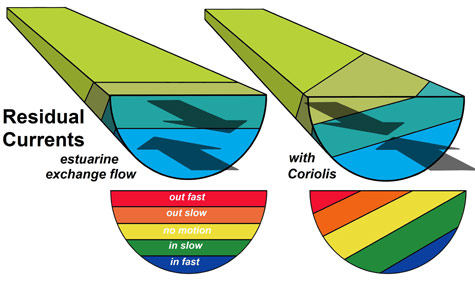|
Estuarine Physical Oceanography
- An idealized estuary... and Long Island Sound (LIS)
- A typical estuary in temperate climates receives fresh water from a river at its head, or farthest up-estuary location, and opens to the coastal ocean at its mouth. This is the idealized setting for the following discussion.
- LIS is atypical: it exchanges with the coastal ocean at both its east and west ends, and most river input occurs along its northern shore. However, the strongest coastal exchange is at the east end, and the freshest water is found at the far west end.
- Eastern LIS, where the ferry samples, is effectively the mouth of the estuary and western LIS its head.
- LIS is a large estuary: about 150 kilometers (93 miles) long, and 15-30 km wide. It varies from about 10 to 90 meters (30 to 270 feet) deep.
- Mixing between fresh and salty water
- High-salinity coastal water enters the mouth. Mixing and redistribution of fresh water causes a horizontal salinity gradation from saltiest water at the mouth to freshest at the head.
- Saltier water is denser, sinks to underlie fresher water, and establishes a layered or “density stratified” vertical structure. This process competes with mixing, driven by winds and tidal currents, that breaks down stratification to homogenize the water vertically.
- Non-tidal residual currents (described below) bring salty water inward at depth near the mouth, to underlie outward-moving fresh water. High salinity extending up-estuary at depth is referred to as a salt intrusion.
- Tilted layers result, each extending from nearer the mouth at the surface to nearer the head at depth, and progressively saltier toward the mouth.

- Tidal currents
- Tidal flow is dominated by semidiurnal motion consisting of cyclic alternating up-estuary "flood" currents and down-estuary "ebb" currents, with about two complete 12.4-hour cycles per day.
- Tidal currents near the seafloor are about as strong as those at the surface. Their back-and-forth motion displaces the tilted layers of varying salinity (described above) in their entirety, as they would a bottle adrift.
- Tidal motion can be the most vigorous component of flow. This is especially true in eastern LIS. It is important to turbulence, mixing, and dispersal of materials.
- Residual currents, or non-tidal “net drift”
- In addition to alternating tidal displacements, a bottle
adrift will have some non-tidal net drift. This
residual current determines where the bottle ends up
after several tidal cycles.
- Residual flow at different depths, unlike tidal
currents, is commonly directed oppositely.
- Residual flow typically consists of a fresher, shallow outward flow that
is nearly balanced by a saltier, deep inward flow. The water carried by
this estuarine exchange flow usually far exceeds freshwater river
inputs. For each 1 unit of river flow there may be, for example, 20
units of outward shallow flow and 19 units of inward deeper flow.

-
Coriolis influence and asymmetric exchange flow
- Because residual flow is slow and persistent, it can be
strongly influenced by the Coriolis effect, due to
the rotation of the earth about its axis. Inward and outward
currents displace rightward (in the Northern hemisphere) of
their direction of flow.
- Coriolis-modified exchange flow, when viewed looking
up-estuary from the mouth, has fresher outward flow near the
surface to the left, and saltier inward flow concentrated at
depth to the right.
- This pattern of exchange flow shown in the lower right of the above graphic, with left-right asymmetric residual currents, should be compared to the ferry-based observations of residual flow.
- Though residual currents are often weaker than
alternating tidal currents, as occurs in eastern LIS, they
have strong influence on the final destination of waterborne
materials and are important in determining water quality.
|